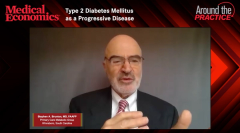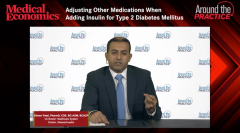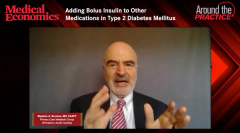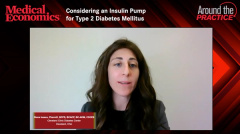
Patient education when starting insulin therapy
Episodes in this series

Dhiren Patel, PharmD, CDE, BC-ADM, BCACP: Diana, you mentioned that you’re getting a lot of referrals. What level of patient education do you provide your team when you’re starting insulin therapy?
Diana Isaacs, PharmD, BCPS, BCACP, BC-ADM, CDCES: There is a lot when someone is starting insulin. We first want to make sure they understand how to administer it if it’s going to be an insulin. We’re usually using insulin pens, but you occasionally have someone who asks for a vial, or they have a wacky insurance that won’t cover the pen. We want to make sure that they understand the administration technique and how much to give. It is also about the monitoring. We don’t just want to start someone on insulin and say, “All right, goodbye. See you in 3 months.”
That glucose monitoring becomes so important. We want patient education on when to monitor, whether that’s through finger sticks or through continuous glucose monitoring, and we should educate on what those numbers mean. We can’t just send someone home and say, “Check 4 times a day.” Then they come back 3 months later, all their readings are 300 mg/dL, and they didn’t know that that wasn’t the target. It’s important to educate on what those targets are to be able to achieve them.
The other essential thing is education on hypoglycemia. Anytime you’re starting insulin, it can cause hypoglycemia, so I want to make sure my patients understand what the symptoms are, and if they then experience those symptoms, they understand how to treat it. Those are really the key things.
Stephen A. Brunton, MD, FAAFP: One of the things that is very important, at least in primary care, is this: A lot of people have some considerations about what insulin means. Everybody has the aunt who lost a leg, so I ask them what their considerations are: “What have you heard about insulin?” That way, you can at least hear their thoughts about it, and you can deal with some of this misinformation. That is actually critical.
The other thing, particularly for us in primary care, is to administer the first shot in the office. I have patients tell me, “I don’t know.” No patient remembers their second insulin shot. It’s always the anxiety about the first 1. If you can administer it in the office, they realize it’s not that hard. I get them to close their eyes, and I pinch 1 arm and inject them in the other—that kind of thing. It may be saline that I’m injecting, but I ask, “Which arm did I inject it in?” They’ll tell me that it was the arm where I pinched. That overcomes some of the anxiety that people have. There is a lot to overcome. Once you overcome that, it becomes a much easier process.
Dhiren Patel, PharmD, CDE, BC-ADM, BCACP: Let me ask you a question on that note: Who provides this education for you? If you aren’t fortunate enough to have Diana with you, who’s doing this? You are all busy because you’re dealing with not only diabetes but also a laundry list of other conditions and 3 forms that you also need to fill out, and you need to squeeze in a physical exam. Who does that education for you?
Stephen A. Brunton, MD, FAAFP: After this conference I’m hiring Diana so it will all be her. Frankly, a lot of it is done with by the clinician who’s managing the patient. Ideally, you can train someone in the office who becomes the diabetes champion, so you don’t have to because it is busy, as you point out. If you have a medical assistant who’s particularly interested in that, particularly if you have a patient with diabetes who works for you, the credibility of the 2 working together really works well.
I had a patient who was very skeptical and a staff member who has type 1 diabetes; they work together and solve all the problems. You can then have somebody sharing their personal experience. It’s not that hard, but you’re right: It takes some time. That’s often a real premium in the primary care office.
Dhiren Patel, PharmD, CDE, BC-ADM, BCACP: Did someone want to say something?
Robert Busch, MD: I’m spoiled to have a lot of educators and PharmDs, but I them myself at times if they’re all busy. As Stephen said, no one complains about the second dose of insulin. Obviously, the insulin is compared with what your blood sugar is and how to titrate. Yes, we’ve seen patients—all of you have—who are on 10 units of insulin for the last 3 months because no one told them part 2: titrate it.
I’ll ask the patient, “How long do you want to live?” They’ll say, “I want to live to 100.” I’ll say, “OK, if you’re over that number for 3 days, go up 2 units. If you’re below 80 mg/dL, cut down 2 units.” I say, “If you’re ever low, then cut down, but if you’re high, wait for a trend, whether it’s 80 to 100 mg/dL.” If it’s an older person, then I might say, “If you’re ever below 100 mg/dL, cut down 4 units. If you’re above 120 or 150 mg/dL for X amount of days, then go up 2 units.”
When I start the insulin, I always review how to titrate the insulin at that time as well. I may not have the hour that the educators or our PharmDs have, but at least if I’m starting insulin, I’m pairing it with how to titrate the basal insulin if I’m doing it then.
Diana Isaacs, PharmD, BCPS, BCACP, BC-ADM, CDCES: I want to add that we [at the Cleveland Clinic Diabetes Center] have a team approach too. Despite what you might think, I don’t educate everybody. Our MAs [medical assistants] and our intake nurses can also teach the insulin administration, and we have other diabetes care and education specialists, dietitians, and nurses. It’s all hands on deck. We all feel comfortable doing it, so someone should be available if someone needs to start it.
Dhiren Patel, PharmD, CDE, BC-ADM, BCACP: Yes. It absolutely takes a village, as we all know, to take care of a patient with diabetes.
Newsletter
Stay informed and empowered with Medical Economics enewsletter, delivering expert insights, financial strategies, practice management tips and technology trends — tailored for today’s physicians.











